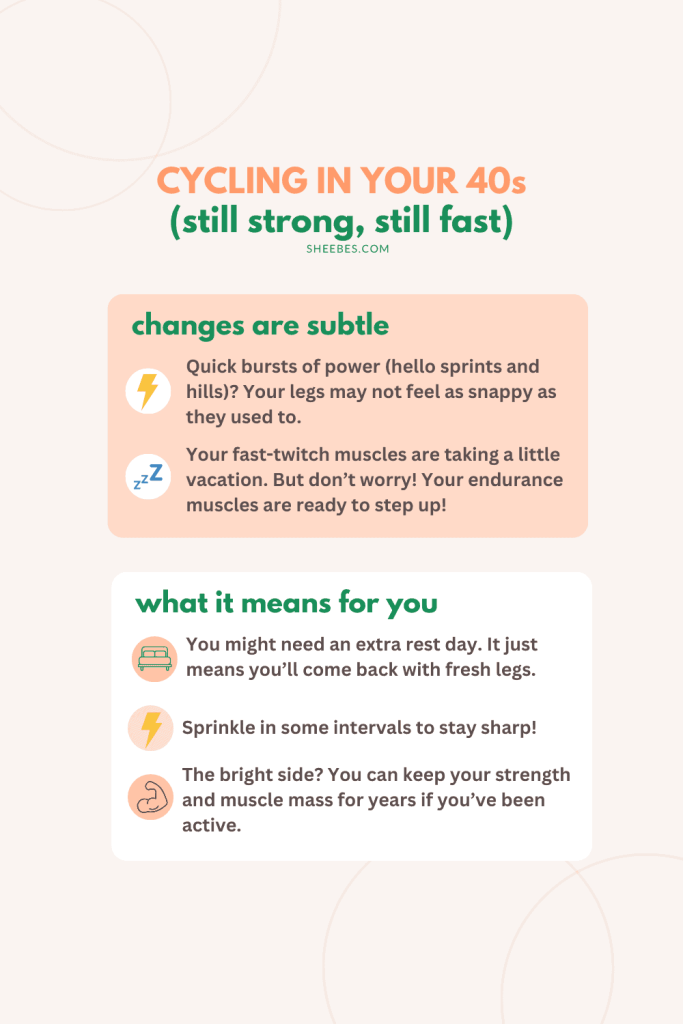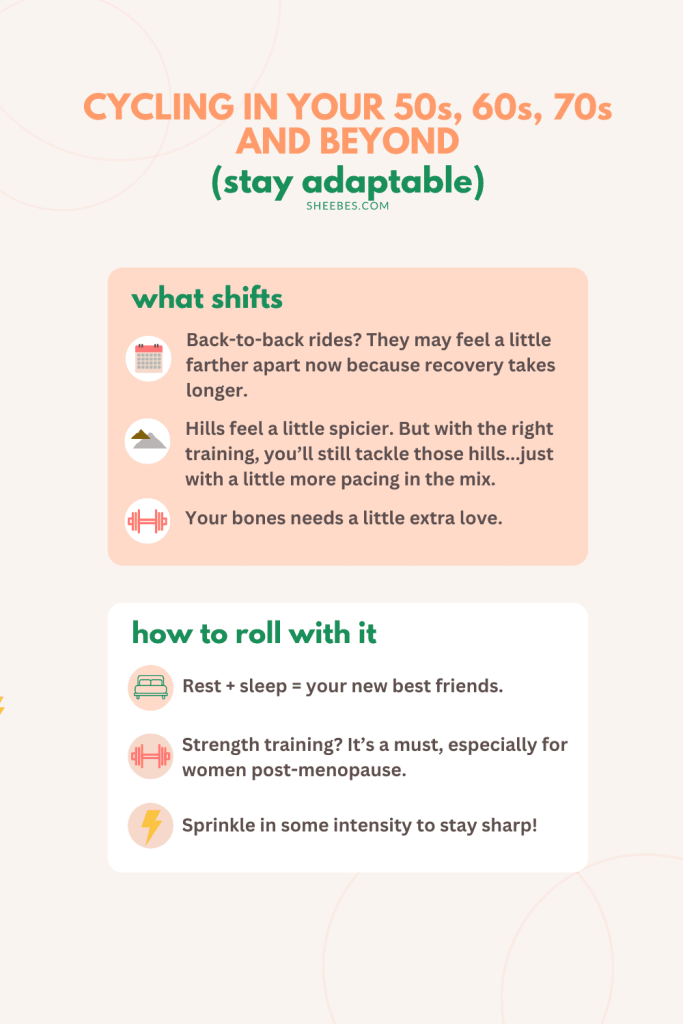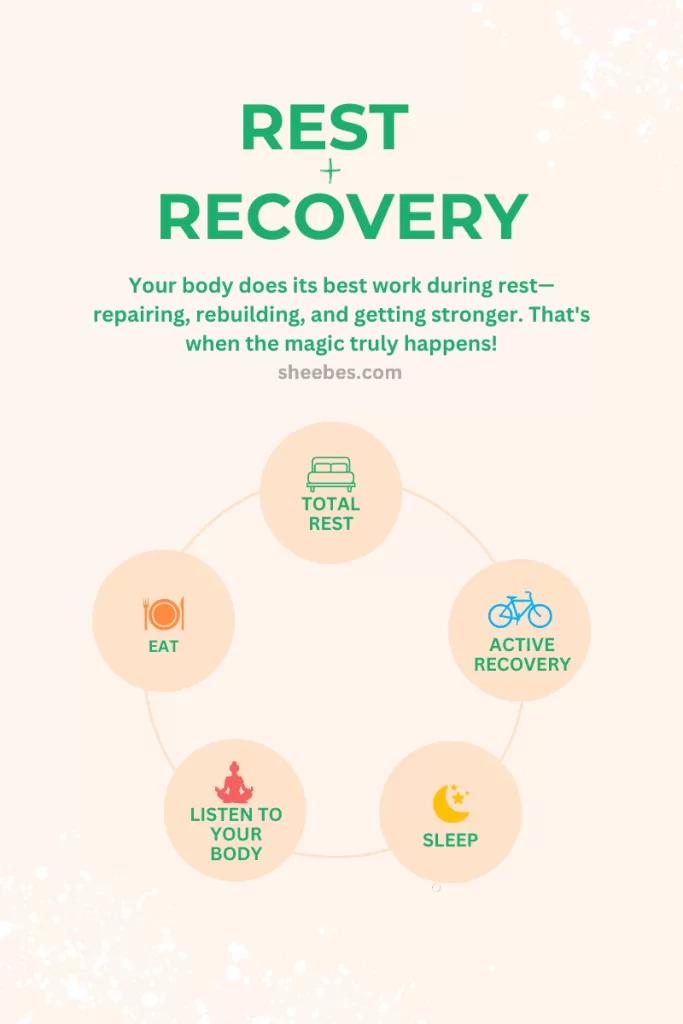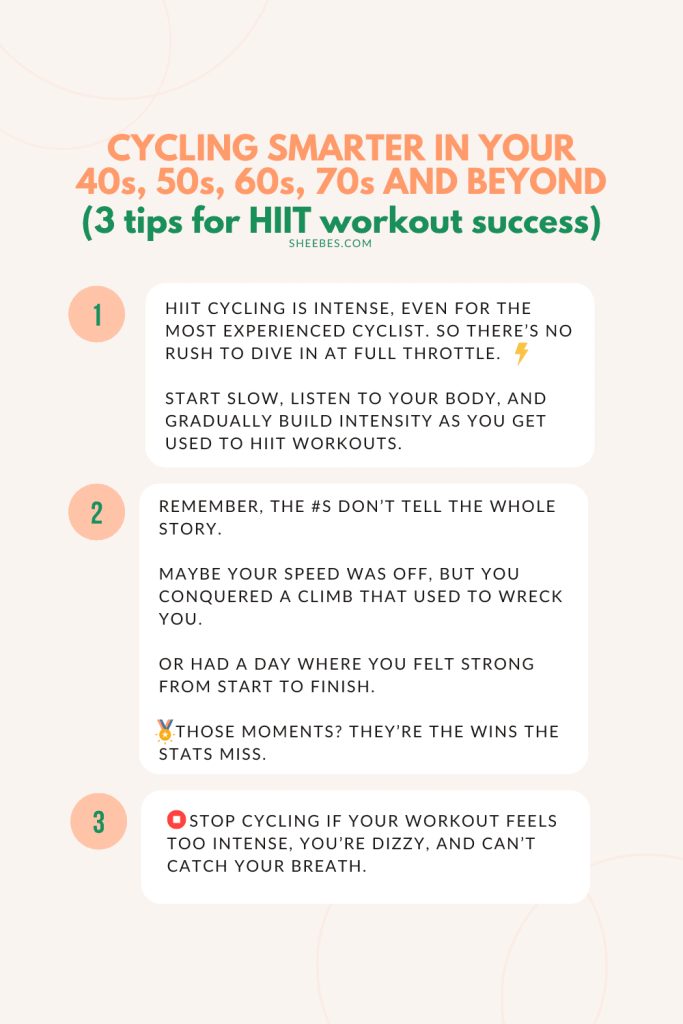Have you been on a ride and thought…”Wait. Shouldn’t this be easy?”
So our natural response?
We dial up the intensity. Put in more work. Add more miles and hope that we’ll return to our past (younger) self.
Reality ✔︎: Muscles now need more time to bounce back. And days off? They’re more of a ‘must-do’ than a ‘maybe.’
When cycling has been a big part of your life…or you’re brand new to this…it’s easy to compare yourself to where you think you should be.
But…what if it’s about riding smarter today, tomorrow, and for years?
Cycling in your 40s, 50s, 60s, and beyond: what really changes?
Yes, your body changes, but that doesn’t mean you can’t stay feeling good in the saddle. Here’s what shifts and how to roll with it.
🚴 Cycling in your 40s: still strong, still fast

In your 40s, changes are subtle:
🔥 Cycling in your 50s, 60s, and beyond: stay adaptable

By your 50s and 60s, 70s, and beyond, things shift a bit more:
Plenty of cyclists in their 40s, 50s, 60s, and beyond are still out there going on rides, getting stronger, and setting PRs.
VO2 max? ✅ Still trainable. (Seffrin et al., 2024) Power? ✅ Still got it.
The trick? Tweaking your approach.
Let’s toss the old metrics and find what really counts now.
Chase feelings, not numbers
Ever checked your stats after a ride and felt…😕?
The #’s don’t tell the full story. Maybe your speed was off, but you conquered a climb that used to wreck you.
Or the day when you felt strong from start to finish.
✨Those feels? It helps you catch the wins the stats miss.✨ (Plus it may help to capture ‘em in an app, so you can relive those moments.)
So maybe…we just skipped the #’s for 1 ride a week? ➡️ Yep, leave the bike computer at home. ⬅️
Just you on two wheels and the open road.
Feeling strong matters, but so does taking care of your body. And guess what? Rest might just be the most powerful part of your training.
Let’s talk about why.
Rest? That’s the new hard work.

Maybe today a ride takes two days to recover instead of one. Totally normal, btw.
That younger version of you? It may have been all about PRs and testing limits.
The you today? You’re still striving, but now it’s the long game. The goal? To be in it for years ahead.
It’s no longer just about pushing but listening to your body. Sometimes that’s going for it. Other times that’s rest.
But how do you KNOW which is right?🤔
That’s exactly why I created my “How to adjust your workouts” guide for you—cyclists who want to train smarter, not just harder.
→ You’ve just finished a great ride or run (cue endorphins! 🙌🏽)
→ But the next day? Your body’s giving mixed signals 😕
→ Do you push through or back off? 🤔
This 10-page guide breaks it down, so you can:
- ✅ Quickly assess how you’re REALLY feeling (mood, soreness, energy, stress)
- ✅ Make confident decisions about your workout intensity
- ✅ Know exactly when to push and when to rest
- ✅ Adjust your training based on how you feel…not just your scheduled plan
No more guesswork. No more wondering if you’re being lazy or smart.
Just clarity on what your body truly needs today.
Your superpower now? Adapting, pacing yourself, and staying consistent.
Rest days aren’t wasted days because you can use ‘em to check in:
- ✅ What felt great last ride?
- ✅ What could use a little more love?
Gentle movement, if it feels right:
Maybe a cycling recovery ride, stretching, a walk with your BFF to catch up on the latest. It’ll boost circulation and keep your muscles repairing while staying in motion.
Active recovery isn’t about sitting still. It’s about smart movement.
A light 20-min ride, stretching, or going for a walk boosts the blood flow to your muscles, speeding up recovery and fending off stiffness.
It’s just as crucial as those all-out efforts.
So don’t write off rest days! They’re the secret ingredient that keeps you strong for the long haul.
Plan your rides with rest in mind (but as always…change things up to suit where you’re at):
- Day 1️⃣: Go hard with intervals or a long ride
- Day 2️⃣: Active recovery…keep it light with an easy spin
- Day 3️⃣: Full rest, no guilt
Training smarter, not harder
We all love the ease of long, slow rides. And tbh, they’re essential.
But balance is everything. You’ve heard of the 80/20 rule right?
It’s from Dr. Stephen Seiler, the exercise physiologist who studied the world’s top endurance athletes (hello, Norwegian cross-country skiers!).
He found a pretty cool secret…the skiers spent ~80% of their time training at a chill, low intensity and ~20% pushing hard.
The result? Norwegian skiers dominate international races, and this method has influenced training across endurance sports. Yep, cycling and running! (Foster, Daniels, & Seiler, 1999)
So the takeaway? If you want to build endurance and you’re cycling in your 40s, 50s, 60s, 70s, go easy most of the time…💡but don’t skip the hard stuff.
Most (that’s 80%) of your rides should be easy-paced and steady. It’ll give your body the endurance it needs without overloading it.
But the other 20%? That’s where we add in some intensity. Short, intense efforts like high-intensity interval training (HIIT) can:
New to HIIT? Returning after a break? Start slow + steady

✅ Kick off with 1 session/week. Think 30 seconds of effort, 90 seconds easy. (Don’t forget the warm-up + cool down!)
For example:
- Warm-up: 10 minutes easy spin
- Intervals: 6x 30 seconds at 90% effort, 90 seconds easy
- Cool-down: 10 minutes gentle pedaling
✅ Make it low-impact. Try hill climbs or seated cycling instead of out of the saddle sprints.
✅ Do your easy rides at a pace where you can hold a conversation.
✅ Give your body 48 hours to recover between HIIT sessions. (But remember, if you need more time, take it! It’s all about working with your body.)
So most of the time? You’re cruising for the long haul. But when it’s time to push? Make those 20% intense moments count.
Your experience + smart training = gains on the bike, no matter your age
Recovery might take a little longer, and muscles don’t bounce back like they used to.
But that just means we train smarter, not harder.
It’s not about stacking up miles but about rest and making every ride count.
You don’t need to be 20 again to crush it on the bike. You’ve got something your younger self didn’t…✨experience✨. And that’s a powerful thing.
Want to use that experience to train smarter (not just harder)?
My How to Adjust Your Workouts guide has you covered. Because the real magic? Knowing when to go all in—and when to dial it back.